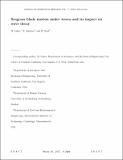| dc.contributor.author | Luhar, M. | |
| dc.contributor.author | Infantes, E. | |
| dc.contributor.author | Nepf, Heidi | |
| dc.date.accessioned | 2018-08-20T14:35:50Z | |
| dc.date.available | 2018-08-20T14:35:50Z | |
| dc.date.issued | 2017-04 | |
| dc.date.submitted | 2017-01 | |
| dc.identifier.issn | 2169-9291 | |
| dc.identifier.uri | http://hdl.handle.net/1721.1/117407 | |
| dc.description.abstract | The hydrodynamic drag generated by seagrass meadows can dissipate wave-energy, causing wave decay. It is well known that this drag depends on the relative motion between the water and the seagrass blades, yet the impact of blade motion on drag and wave-energy dissipation remains to be fully characterized. In this experimental study, we examined the impact of blade motion on wave decay by concurrently recording blade posture during a wave cycle and measuring wave decay over a model seagrass meadow. We also identified a scaling law that predicts wave decay over the model meadow for a range of seagrass blade density, wave period, wave height, and water depth scaled from typical field conditions. Blade flexibility led to significantly lower drag and wave decay relative to theoretical predictions for rigid, upright blades. To quantify the impact of blade motion on wave decay, we employed an effective blade length, le, defined as the rigid blade length that leads to equivalent wave-energy dissipation. We estimated ledirectly from images of blade motion. Consistent with previous studies, these estimates showed that the effective blade length depends on the dimensionless Cauchy number, which describes the relative magnitude of the wave hydrodynamic drag and the restoring force due to blade rigidity. As the hydrodynamic forcing increases, the blades exhibit greater motion. Greater blade motion leads to smaller relative velocities, reducing drag, and wave-energy dissipation (i.e., smaller le). Keywords: wave-energy dissipation; seagrass; flexible vegetation | en_US |
| dc.description.sponsorship | National Science Foundation (U.S.) (Grant OCE 0751358) | en_US |
| dc.description.sponsorship | National Science Foundation (U.S.) (Grant EAR 6935738) | en_US |
| dc.publisher | American Geophysical Union (AGU) | en_US |
| dc.relation.isversionof | http://dx.doi.org/10.1002/2017JC012731 | en_US |
| dc.rights | Creative Commons Attribution-Noncommercial-Share Alike | en_US |
| dc.rights.uri | http://creativecommons.org/licenses/by-nc-sa/4.0/ | en_US |
| dc.source | Other repository | en_US |
| dc.title | Seagrass blade motion under waves and its impact on wave decay | en_US |
| dc.type | Article | en_US |
| dc.identifier.citation | Luhar, M. et al. “Seagrass Blade Motion Under Waves and Its Impact on Wave Decay.” Journal of Geophysical Research: Oceans 122, 5 (May 2017): 3736–3752 © 2017 American Geophysical Union | en_US |
| dc.contributor.department | Massachusetts Institute of Technology. Department of Civil and Environmental Engineering | en_US |
| dc.contributor.mitauthor | Nepf, Heidi | |
| dc.relation.journal | Journal of Geophysical Research: Oceans | en_US |
| dc.eprint.version | Original manuscript | en_US |
| dc.type.uri | http://purl.org/eprint/type/JournalArticle | en_US |
| eprint.status | http://purl.org/eprint/status/NonPeerReviewed | en_US |
| dc.date.updated | 2018-08-20T12:42:00Z | |
| dspace.orderedauthors | Luhar, M.; Infantes, E.; Nepf, H. | en_US |
| dspace.embargo.terms | N | en_US |
| mit.license | OPEN_ACCESS_POLICY | en_US |
